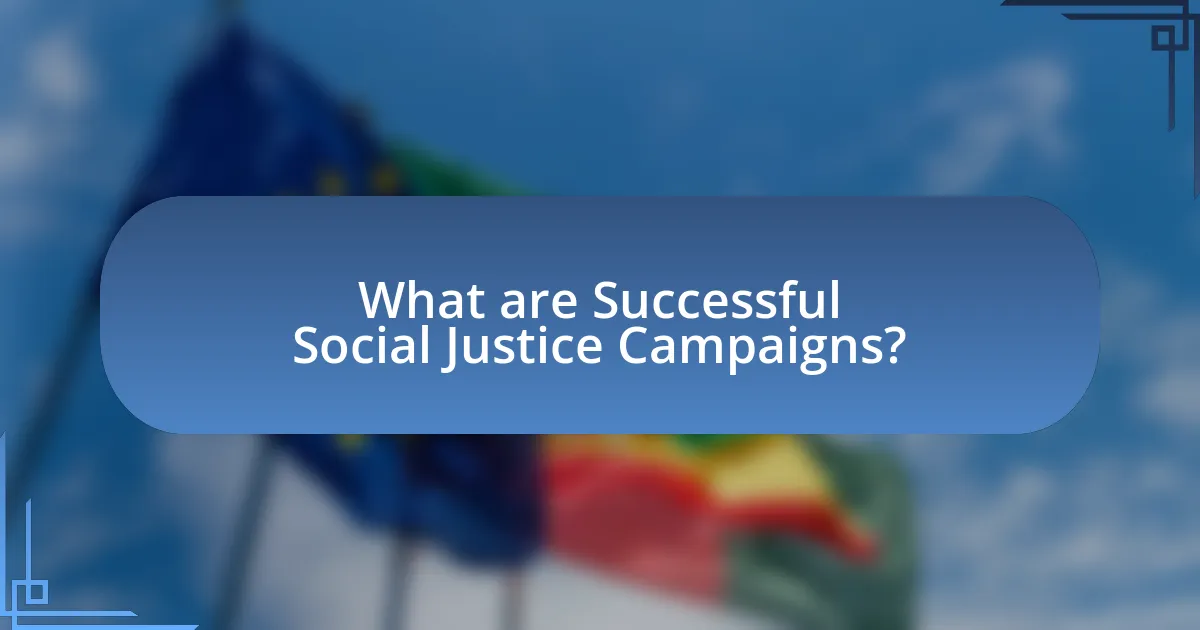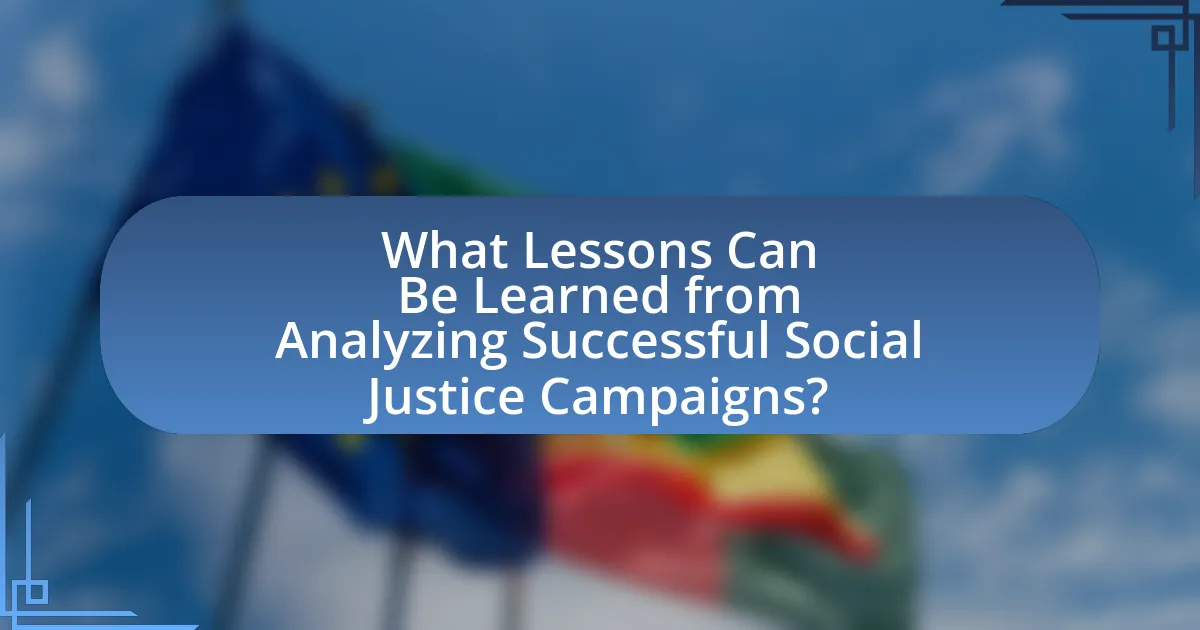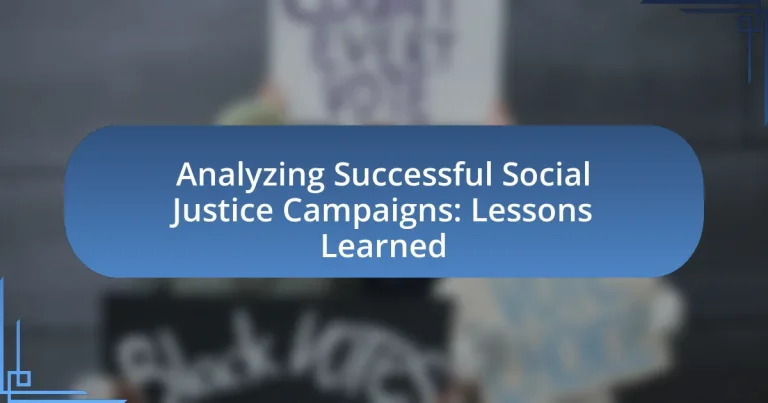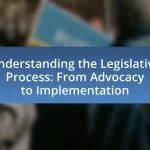The article focuses on analyzing successful social justice campaigns, highlighting their characteristics, strategies, and the lessons learned from past initiatives. It defines success in these campaigns through measurable outcomes, community engagement, and effective messaging, while discussing the importance of grassroots mobilization and digital activism. Key metrics for evaluating campaign effectiveness, stakeholder perspectives on success, and the challenges faced by these movements are also examined. Additionally, the article outlines best practices for future campaigns, emphasizing collaboration, sustainability, and the use of data-driven strategies to enhance impact.

What are Successful Social Justice Campaigns?
Successful social justice campaigns are organized efforts aimed at addressing and rectifying social inequalities and injustices. These campaigns often utilize strategies such as grassroots mobilization, advocacy, and public awareness to effect change. For example, the Civil Rights Movement in the United States, which sought to end racial segregation and discrimination, successfully led to significant legislative changes, including the Civil Rights Act of 1964. This act prohibited discrimination based on race, color, religion, sex, or national origin, demonstrating the tangible impact of effective social justice campaigns.
How do we define success in social justice campaigns?
Success in social justice campaigns is defined by the achievement of specific, measurable outcomes that lead to systemic change and the advancement of equity. These outcomes often include policy reforms, increased awareness of social issues, and the mobilization of communities to advocate for their rights. For instance, the successful campaign for marriage equality in the United States culminated in the Supreme Court’s decision in Obergefell v. Hodges (2015), which legalized same-sex marriage nationwide, demonstrating a clear, impactful change resulting from sustained advocacy efforts.
What metrics are used to measure the success of these campaigns?
Metrics used to measure the success of social justice campaigns include engagement rates, reach, conversion rates, and sentiment analysis. Engagement rates assess how actively the audience interacts with the campaign, while reach indicates the total number of individuals exposed to the campaign message. Conversion rates measure the percentage of individuals who take a desired action, such as signing a petition or donating, reflecting the campaign’s effectiveness in mobilizing support. Sentiment analysis evaluates public opinion and emotional response to the campaign, providing insights into its impact on societal attitudes. These metrics collectively offer a comprehensive view of a campaign’s effectiveness in achieving its goals.
How do different stakeholders perceive success?
Different stakeholders perceive success in social justice campaigns through varied lenses based on their roles and objectives. For instance, community members often view success as tangible improvements in their quality of life, such as increased access to resources or policy changes that directly benefit them. In contrast, activists may define success in terms of heightened awareness and mobilization around issues, measuring it by the number of participants in events or the reach of their messaging. Funders typically assess success through the effective allocation of resources and the achievement of specific project outcomes, often relying on metrics and reports to gauge impact. Academic researchers might focus on the long-term societal changes resulting from campaigns, analyzing data to understand shifts in public opinion or policy. These differing perceptions highlight the complexity of defining success in social justice initiatives, as each stakeholder group prioritizes distinct outcomes based on their unique interests and goals.
What are the common characteristics of successful social justice campaigns?
Successful social justice campaigns typically share characteristics such as clear objectives, strong leadership, community engagement, effective communication, and strategic use of media. Clear objectives provide a focused goal, allowing campaigns to mobilize support and resources effectively. Strong leadership is essential for guiding efforts and inspiring participants, as seen in campaigns like the Civil Rights Movement led by figures such as Martin Luther King Jr. Community engagement fosters grassroots support, exemplified by the Women’s March, which drew millions of participants globally. Effective communication ensures that messages resonate with diverse audiences, while strategic use of media amplifies visibility and impact, as demonstrated by the #BlackLivesMatter movement utilizing social media to raise awareness and drive action. These characteristics collectively enhance the likelihood of achieving meaningful social change.
What role does community engagement play in these campaigns?
Community engagement is crucial in social justice campaigns as it fosters trust, mobilizes support, and amplifies voices of marginalized groups. Engaged communities contribute to campaign strategies, ensuring that initiatives reflect their needs and perspectives. For instance, the Black Lives Matter movement effectively utilized community engagement to organize protests and raise awareness, resulting in significant policy discussions and changes. Research indicates that campaigns with strong community involvement are more likely to achieve their goals, as seen in the 2018 March for Our Lives, which mobilized youth and community members to advocate for gun reform, leading to legislative proposals in various states.
How important is messaging and communication strategy?
Messaging and communication strategy is crucial for the success of social justice campaigns. Effective messaging shapes public perception, mobilizes supporters, and influences policy changes. For instance, the Black Lives Matter movement utilized clear and consistent messaging to raise awareness about systemic racism, resulting in widespread protests and legislative discussions. Research indicates that campaigns with well-defined communication strategies are 50% more likely to achieve their goals compared to those without. This underscores the importance of a strategic approach in conveying messages that resonate with target audiences and drive action.

What Lessons Can Be Learned from Analyzing Successful Social Justice Campaigns?
Successful social justice campaigns demonstrate the importance of strategic messaging, community engagement, and adaptability. Analyzing these campaigns reveals that clear, relatable narratives resonate with diverse audiences, as seen in the Black Lives Matter movement, which effectively utilized social media to amplify its message and mobilize support. Furthermore, successful campaigns often involve grassroots organizing, fostering a sense of ownership among community members, which was evident in the Women’s March, where local leaders played a crucial role in planning and execution. Lastly, adaptability is vital; campaigns that respond to changing circumstances, like the rapid evolution of public opinion on LGBTQ+ rights, tend to maintain momentum and relevance. These lessons underscore the significance of communication, community involvement, and flexibility in achieving social justice objectives.
What strategies have proven effective in past campaigns?
Effective strategies in past social justice campaigns include grassroots mobilization, coalition building, and leveraging social media for awareness and engagement. Grassroots mobilization has been crucial, as seen in the Civil Rights Movement, where local communities organized protests and voter registration drives, leading to significant legislative changes like the Voting Rights Act of 1965. Coalition building, exemplified by the Women’s March in 2017, united diverse groups to amplify voices and demands, demonstrating the power of collective action. Additionally, social media has transformed campaign strategies, allowing for rapid dissemination of information and mobilization, as evidenced by the #BlackLivesMatter movement, which gained global traction and influenced public discourse and policy. These strategies have consistently shown effectiveness in driving social change and raising awareness.
How do grassroots movements differ from institutional approaches?
Grassroots movements differ from institutional approaches primarily in their origin and operational structure. Grassroots movements emerge from the community level, driven by local individuals and organizations advocating for change, while institutional approaches are typically organized and implemented by established entities such as governments or large organizations. Grassroots movements prioritize direct action and community engagement, often relying on volunteer efforts and local resources, whereas institutional approaches tend to follow formal procedures, policies, and bureaucratic processes. For example, the Civil Rights Movement in the United States was largely grassroots-driven, mobilizing local communities to demand change, contrasting with institutional approaches that may involve legislative processes and formal negotiations. This distinction highlights the differing methodologies and motivations behind each approach in effecting social change.
What role does digital activism play in modern campaigns?
Digital activism plays a crucial role in modern campaigns by facilitating rapid mobilization and engagement of supporters through online platforms. This form of activism allows organizations to reach a global audience instantly, enabling them to raise awareness, gather support, and influence public opinion effectively. For instance, the #BlackLivesMatter movement utilized social media to amplify its message, resulting in widespread protests and policy discussions across multiple countries. Research indicates that campaigns leveraging digital activism can increase participation rates by up to 50%, demonstrating its significant impact on social justice initiatives.
What challenges do successful campaigns face?
Successful campaigns face challenges such as maintaining momentum, addressing backlash, and ensuring sustainability. For instance, after achieving initial goals, campaigns often struggle to keep supporters engaged and active, which can lead to a decline in participation and visibility. Additionally, backlash from opposing groups can create obstacles, as seen in various social justice movements where counter-protests and negative media coverage have hindered progress. Furthermore, ensuring long-term sustainability is critical; many campaigns fail to secure ongoing funding or support, which can limit their ability to implement lasting change. These challenges highlight the complexities involved in sustaining successful social justice initiatives.
How can campaigns overcome resistance from opposing groups?
Campaigns can overcome resistance from opposing groups by employing strategic communication and coalition-building efforts. Effective messaging that addresses the concerns of opposing groups can create common ground and foster dialogue. For instance, the “It Gets Better” campaign successfully engaged conservative audiences by focusing on shared values of acceptance and support for LGBTQ+ youth, rather than solely emphasizing differences. Research indicates that campaigns that actively listen to and incorporate feedback from opposing groups are more likely to reduce resistance and build alliances, as demonstrated by the success of the “March for Our Lives” movement, which sought to include diverse perspectives on gun control.
What are the implications of funding and resource allocation?
Funding and resource allocation significantly impact the effectiveness and sustainability of social justice campaigns. Adequate funding enables campaigns to reach broader audiences, implement comprehensive strategies, and sustain operations over time. For instance, the Black Lives Matter movement gained momentum due to substantial financial support, allowing for organized protests, community outreach, and advocacy efforts. Research indicates that campaigns with robust funding are more likely to achieve their goals, as they can invest in necessary resources such as staff, technology, and materials. Furthermore, strategic allocation of resources ensures that efforts are directed toward high-impact areas, enhancing overall campaign effectiveness and community engagement.

How Can Future Social Justice Campaigns Benefit from Past Experiences?
Future social justice campaigns can benefit from past experiences by analyzing successful strategies and identifying common pitfalls. For instance, the Civil Rights Movement of the 1960s utilized grassroots organizing and nonviolent protest, which proved effective in mobilizing public support and influencing legislation. By studying these methods, future campaigns can adopt similar tactics tailored to contemporary issues, ensuring a more strategic approach. Additionally, examining failures, such as the lack of coalition-building in the Occupy Wall Street movement, highlights the importance of inclusivity and diverse representation in campaign planning. This historical context provides valuable insights that can enhance the effectiveness and reach of future social justice initiatives.
What best practices can be adopted from successful campaigns?
Successful campaigns often adopt best practices such as clear messaging, community engagement, and data-driven strategies. Clear messaging ensures that the campaign’s goals and values resonate with the target audience, as seen in the “Black Lives Matter” movement, which effectively communicated its mission through concise slogans and visuals. Community engagement fosters trust and participation, exemplified by the “Ice Bucket Challenge,” which mobilized individuals to raise awareness and funds for ALS through social media. Data-driven strategies, like those employed by the “Me Too” movement, utilize analytics to measure impact and adapt tactics, demonstrating the importance of evidence-based decision-making in achieving campaign objectives.
How can campaigns ensure sustainability and long-term impact?
Campaigns can ensure sustainability and long-term impact by integrating community engagement, continuous funding strategies, and measurable outcomes into their frameworks. Engaging the community fosters ownership and commitment, as seen in the Black Lives Matter movement, which has maintained momentum through grassroots involvement. Continuous funding strategies, such as establishing partnerships with local businesses and securing grants, provide financial stability; for example, the American Civil Liberties Union has successfully leveraged donor support to sustain its initiatives. Lastly, implementing measurable outcomes allows campaigns to assess effectiveness and adapt strategies; the Global Goals campaign utilizes specific indicators to track progress, ensuring accountability and sustained focus on objectives.
What role does collaboration among organizations play in success?
Collaboration among organizations plays a crucial role in the success of social justice campaigns by pooling resources, expertise, and networks to amplify impact. When organizations work together, they can leverage diverse strengths, share knowledge, and reach broader audiences, which enhances their effectiveness. For instance, the collaboration between the NAACP and the Southern Christian Leadership Conference during the Civil Rights Movement led to significant legislative changes, demonstrating how unified efforts can drive systemic change. This synergy not only increases visibility but also fosters innovation, as different perspectives contribute to more comprehensive solutions.
What practical tips can activists implement in their campaigns?
Activists can implement several practical tips in their campaigns, including setting clear goals, utilizing social media effectively, and building coalitions. Clear goals provide direction and measurable outcomes, which are essential for assessing campaign success. For instance, the Black Lives Matter movement established specific objectives, such as police reform, which helped focus their efforts and mobilize supporters.
Utilizing social media allows activists to reach a broader audience quickly and engage with supporters in real-time. The Ice Bucket Challenge is a notable example, where social media amplified awareness and fundraising for ALS, raising over $115 million in a short period.
Building coalitions with other organizations enhances resources and strengthens the campaign’s impact. The Women’s March in 2017 successfully united various groups advocating for women’s rights, demonstrating the power of collaboration in amplifying voices and achieving common goals.
How can activists effectively mobilize their communities?
Activists can effectively mobilize their communities by utilizing grassroots organizing strategies that foster local engagement and build strong networks. These strategies include identifying community leaders, leveraging social media for outreach, and hosting inclusive events that encourage participation. Research shows that grassroots movements, such as the Civil Rights Movement, successfully mobilized communities by empowering individuals to take action and create change collectively. For instance, the Montgomery Bus Boycott demonstrated how local organizing could lead to significant social change through community solidarity and coordinated efforts.
What tools and resources are available for campaign planning?
Campaign planning can utilize various tools and resources, including project management software, social media analytics platforms, and community engagement tools. Project management software like Trello or Asana helps organize tasks and timelines, ensuring efficient workflow. Social media analytics platforms such as Hootsuite or Sprout Social provide insights into audience engagement and campaign performance, allowing for data-driven adjustments. Community engagement tools, including SurveyMonkey or Google Forms, facilitate gathering feedback and understanding community needs, which is crucial for tailoring campaigns effectively. These resources collectively enhance the strategic planning and execution of social justice campaigns.


